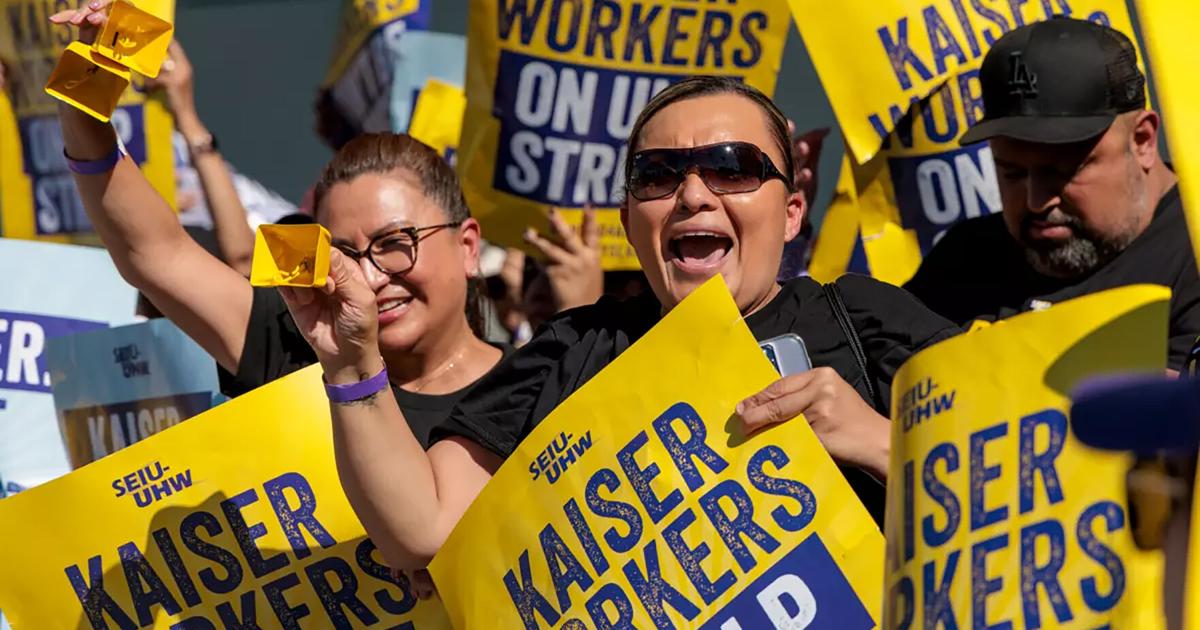The largest health care strike in U.S. history was called off Thursday when Kaiser Permanente and unions representing 75,000 workers finally reached a tentative agreement. This, after a planned three-day work stoppage by the unions, gave their employer a glimpse of what would have happened if the impasse persisted. Kaiser clearly wasn’t interested in seeing more.
This is good news for American workers, who quickly felt the effects of record inflation but were slow to reap the benefits of the resulting record profits. Since last August, we have seen 42 work stoppages affecting at least 1,000 employees across the country, according to the Bureau of Labor Statistics. There’s a theme here as workers have been squeezed too hard for too long, as if the company’s think tank thinks The Hunger Games is a how-to manual.
It’s not just that wages have been slow to rise, and it’s not just that the rise in housing and food prices has outpaced inflation. Look at the barriers we have created to prevent adequate child care.
As of late last month, states face a $39 billion loss in federal child care funding, a financial catastrophe that threatens the solvency of 70,000 programs, the employment of more than 200,000 workers and care for more than 3 million children. .
There was a child care crisis even before the pandemic, said Sen. Patty Murray (D-Wash.). Last month, she and other Democratic senators introduced a bill to try to soften the blow of losing that aid. It’s an urgent economic priority at every level: child care allows parents to go to work, businesses to hire workers, and it’s an investment in the future of our children. The child care industry supports all sectors of our economy.
Before the pandemic, the Department of Health and Human Services reported that what families spent on child care was about 40% more than what was considered affordable. Combine that with the fact that this year’s average salary increases are lower than last year’s pace. And the fact that the purchasing power gap caused by record inflation is expected to last until the end of 2024.
What exactly are working parents supposed to do?
While many white-collar industries offer childcare options, the fastest-growing leisure and hospitality sector isn’t exactly a leader in this area. In Germany, municipalities are required by law to provide childcare services. In America, they were less accommodating. In a sense, don’t have kids unless you can afford them.
The problem is that we lack people who can raise children without help.
September marked the 33rd consecutive month in which the U.S. economy added jobs. The labor force participation rate is increasing and there are more than 9 million job vacancies across the country. This is great news unless you need child care. Next, you need to determine whether any of the available jobs would pay you more than you would spend on child care, assuming you are not one of the 50% of Americans who live in what are known as childcare deserts, areas of America where before-K corps outnumber available spots.
It’s a never-ending financial and logistical burden on the entire family, Murray said.
Take your pick Conservatives on Medicaid, Welfare, and Social Security have always talked about entitlements and safety nets as if those who would benefit from them were lazy and not in the workforce. The reality of how inaccurate this assessment is is about to hit them in the face because of the connection between work and child care.
These people would rather cut government programs than fund social services, but here’s the problem: If potential workers can’t afford to work, how exactly is austerity going to solve the problem?
When we talk about the work ethic of the Greatest Generation, we often forget the part where the federal government stepped in and subsidized the construction of day care centers and everything else. Without this aid, most of the 6 million women who kept this country alive during World War II would not have been able to enter the workforce.
In contrast, today, 68 percent of Oklahomans live in a child care desert. The state is also estimated to be short 40,000 workers. Do you think it’s a coincidence?
The proliferation of the gig economy, combined with the passage of the Affordable Care Act, helped create a path for more Americans to move away from toxic work environments and be their own boss . The Great Resignation and the wave of labor strikes further highlight the shift in the relationship between labor and capital. Yet as seismic as these changes are, the biggest earthquake is yet to come. Paid family leave and affordable child care are no longer just items on liberals’ wish lists.
Like the rest of the industrialized world, America is realizing that if we want people to work, that idea has to work for their children, too.
LZ Granderson is an opinion columnist for the Los Angeles Times.
#Comment #American #policy #fundamentally #discourages #children #economy #paying #price
Image Source : www.union-bulletin.com

